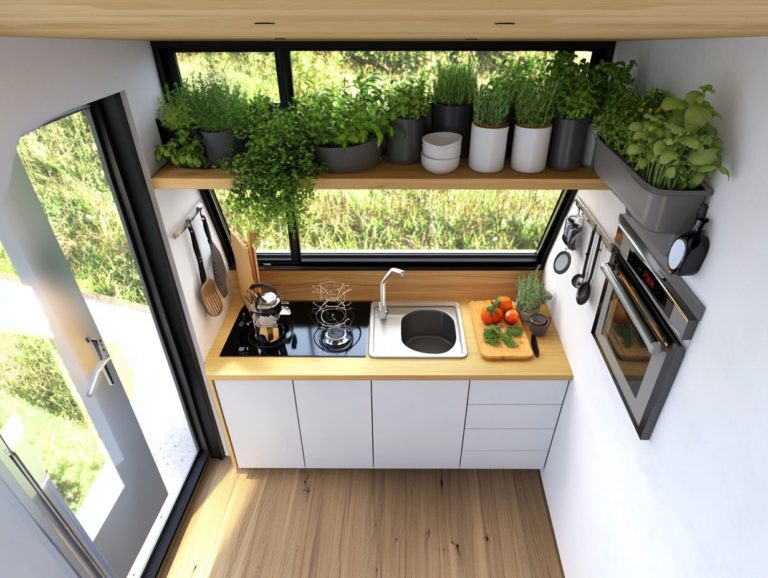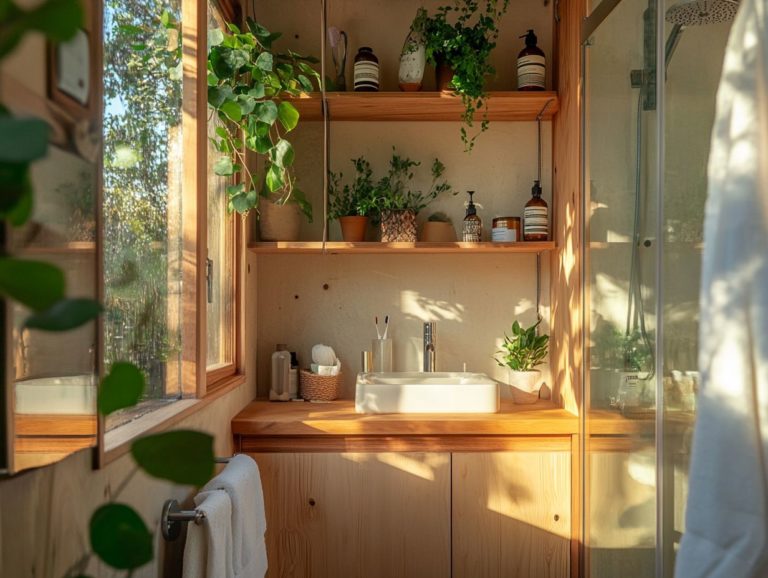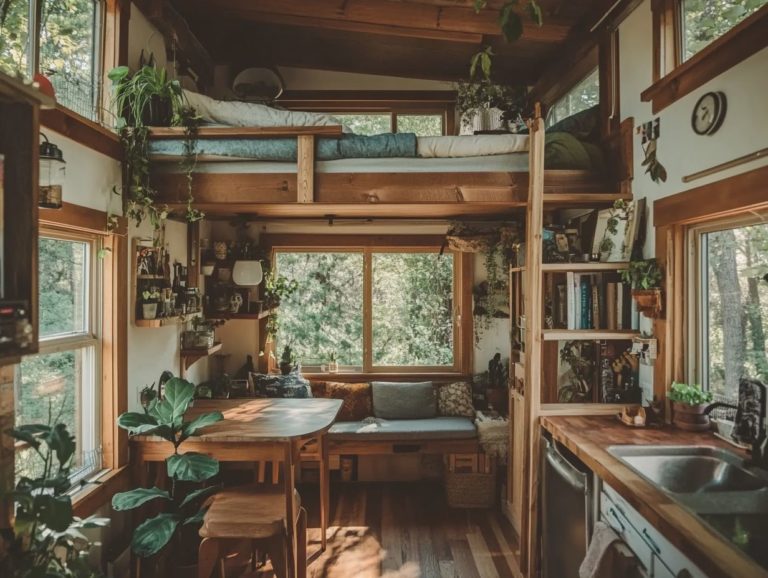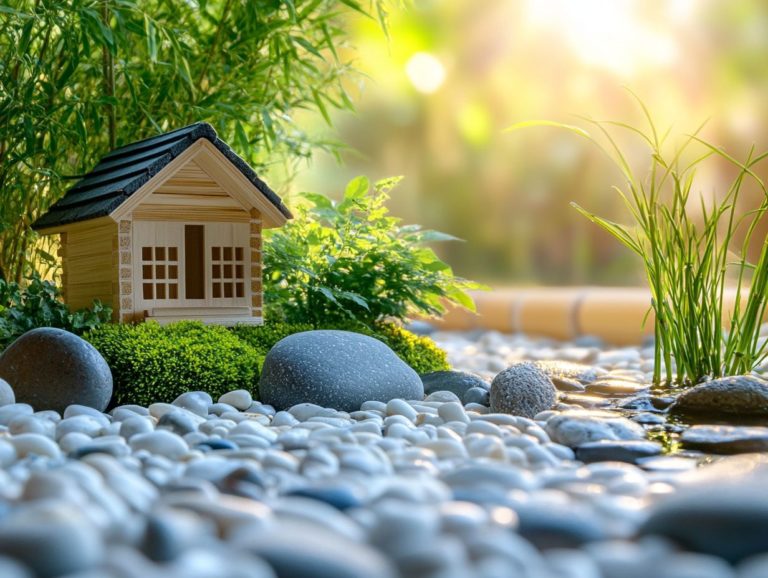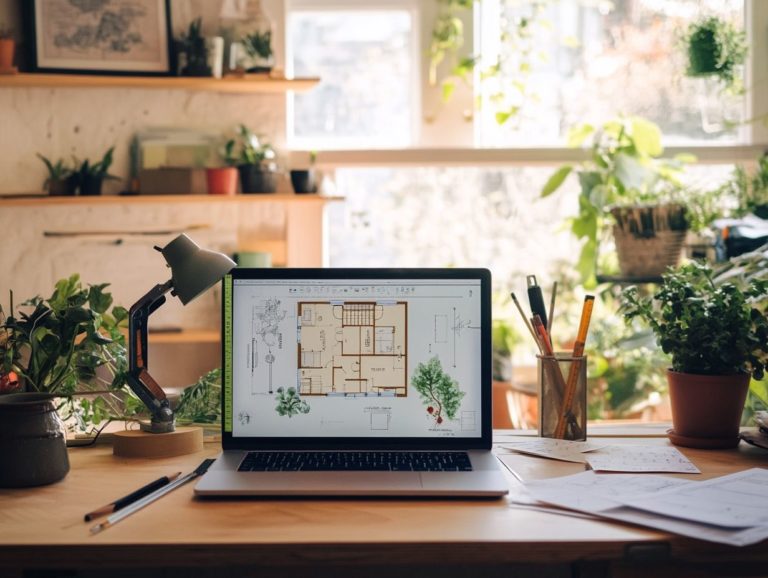DIY Solutions for Tiny House Electrical Needs
Designing an electrical system for your tiny house is a thrilling challenge! It s essential for creating a comfortable and functional living space, especially with exciting options like solar systems and energy-efficient appliances.
This guide will walk you through the fundamentals, highlighting the key factors to consider, various types of electrical systems worth exploring, and a step-by-step installation process for temporary power connections to simplify your journey.
You ll also find insights into common electrical issues and troubleshooting tips to ensure your system operates seamlessly.
Plus, there s valuable maintenance advice to help you keep everything running smoothly for years to come.
Are you ready to power up your tiny home?
Contents [hide]
- Key Takeaways:
- Understanding the Basics
- Designing an Electrical System for Your Tiny House
- DIY Electrical Solutions for Tiny Houses
- Common Electrical Issues in Tiny Houses
- Maintaining Your Tiny House Electrical System
- Frequently Asked Questions
- What are some DIY solutions for tiny house electrical needs?
- Do I need to hire a professional electrician for my tiny house?
- How can I ensure safety when working on the electrical system in my tiny house?
- Can I use regular household appliances in a tiny house?
- What is the best way to plan the electrical layout for a tiny house?
- What codes do I need to follow for tiny house electrical systems?
Key Takeaways:
- Understand the basics of electrical systems to design a safe and efficient setup for your tiny house.
- Consider factors such as power needs, space limitations, and budget when choosing a DIY solution for your tiny house electrical system.
- Regular maintenance and proper troubleshooting techniques can help you avoid and resolve common electrical issues in your tiny house.
Understanding the Basics
Grasping the fundamentals of electricity is crucial as you embark on setting up your tiny house electrical system, particularly if your goal is to live sustainably and efficiently.
Tiny houses demand thoughtful considerations given their limited spaces. You’ll need to weigh options between traditional connections and solar systems. For those seeking practical solutions, exploring quick DIY fixes for tiny house problems can be beneficial. It’s important to follow the National Electric Code (NEC) for safety throughout your setup.
A solid understanding of basic electrical principles such as volts, amps, watts, and the amount of energy used over time will empower you to maximize energy efficiency and minimize costs effectively.
Designing an Electrical System for Your Tiny House
Designing an electrical system for your tiny house is an essential step that requires careful planning to effectively meet your energy needs while prioritizing safety and regulatory compliance according to the International Code Council.
You’ll want to consider integrating solar systems for sustainable energy and selecting the right breaker box the panel that controls your house’s electrical circuits and wiring. Mastering grounding techniques is also important to avert electrical hazards.
Each of these components is crucial for optimizing energy usage and ensuring the reliability of your system.
Factors to Consider
When designing the electrical system for your tiny house, several critical factors must be considered to meet your specific energy needs. This includes calculating electrical needs and assessing your energy consumption. You ll want to assess your lifestyle and energy consumption patterns, guiding you in accurately calculating your electrical requirements whether you prefer traditional sources or are leaning towards solar electric options.
Integrating energy-efficient appliances, such as LED bulbs, smart outlets, and efficient options like a refrigerator and dryer, can significantly lower your overall electricity usage, making it easier to stay within your budget. Understanding average energy consumption and calculating peak demand are essential for effective capacity planning, ensuring that your tiny house remains comfortable in all conditions.
You can seamlessly integrate various energy sources like solar panels or wind turbines into your setup, providing a sustainable power supply for your tiny house. By prioritizing these elements, you can establish a reliable and eco-friendly electrical system tailored specifically to your tiny living space, especially with DIY tiny house solutions for minimalist living.
DIY Electrical Solutions for Tiny Houses
DIY electrical solutions for tiny houses empower you to take charge of your energy requirements while fostering creativity and self-sufficiency. By harnessing your understanding of basic electrical systems like solar panels and energy-efficient options you can design a customized setup that minimizes costs and maximizes functionality.
However, it’s essential to grasp the limitations and adhere to safety protocols, particularly when working with various breakers and ensuring proper grounding.
Types of Electrical Systems
Building your tiny house’s electrical system can be exciting and empowering! Regarding electrical systems for tiny houses, you have several options, each bringing its own set of benefits and challenges. Your choice will hinge on your specific energy needs, lifestyle, and budget.
Understanding these systems helps you make informed decisions that resonate with your sustainability goals and energy consumption habits, especially when considering options like solar electric systems.
Grid-tied systems typically incorporate solar panels that transform sunlight into electricity, which is then fed back into the local electricity grid. This arrangement not only enhances energy efficiency by allowing you to tap into the grid’s power when needed, but it also opens the door to potential savings through net metering, a system that lets you earn credit for excess electricity you feed back into the grid.
On the other hand, off-grid setups heavily depend on solar panels and batteries to store energy for those cloudy days. While the upfront investment for off-grid systems might be steeper, they offer unmatched independence and resilience against grid outages.
Every system requires thoughtful consideration of components, such as inverters, which are devices that change solar energy into usable electricity. These play a crucial role in your overall energy efficiency.
Step-by-Step Installation Guide
Installing an electrical system in your tiny house can be a truly rewarding DIY project, especially when you follow a well-structured, step-by-step guide that prioritizes safety and complies with the National Electric Code. Start with a thorough planning phase, mapping out your system layout, selecting the right breaker box and wiring, and implementing solid grounding techniques.
Following a step-by-step installation process is crucial for achieving a reliable and efficient electrical system that meets your specific needs.
Once you ve completed your initial assessment, gather all the necessary tools, such as wire strippers, a multimeter, and essential safety gear like gloves and goggles. As you move forward, review local building codes and electrical regulations that apply specifically to tiny homes.
You might encounter common challenges during installation, like navigating limited space and ensuring that all connections are secure to prevent shorts or overloads. Regularly checking your work at each stage boosts your confidence and enhances safety, making the effort worthwhile. Additionally, consider incorporating unique DIY tiny house lighting ideas to elevate your setup and ensure a successful electrical configuration for years to come.
Common Electrical Issues in Tiny Houses
Common electrical issues in tiny houses often stem from improper installation, equipment failures, or the distinctive challenges posed by compact living. Grasping these problems is essential for prompt troubleshooting and can help avert potential safety hazards.
While you might be inclined to tackle DIY repairs, certain situations may warrant professional assistance to navigate complex issues effectively and ensure compliance with the Code.
Identifying and Troubleshooting Problems
Identifying and troubleshooting electrical problems in your tiny house requires a careful step-by-step method to ensure that your electrical system remains both operational and safe. Begin by inspecting the breaker box for any tripped breakers, checking for proper grounding, and monitoring your usage of volts, amps, and watts to spot any potential overloads.
Start by carefully assessing the breaker box and looking for any breakers that have flipped to the ‘off’ position. A simple reset might just do the trick, but if this occurs frequently, it could be a sign of a more significant issue lurking beneath the surface.
Regularly checking your grounding connections is crucial for maintaining safety and efficiency. Employing electrical meters to assess your energy consumption will provide you with accurate readings of your usage patterns, allowing you to identify devices that may be consuming excess power.
This proactive approach not only facilitates troubleshooting but also enhances your energy efficiency over time by carefully monitoring electrical consumption, ensuring that your tiny house operates smoothly and sustainably.
Act quickly to secure your setup against potential issues! With proper planning and care, your tiny home’s electrical system will serve you well for years!
Maintaining Your Tiny House Electrical System
Maintaining your tiny house electrical system is crucial for its longevity, efficiency, and safety. Regular upkeep helps you avoid common issues and enhances energy savings, especially by utilizing energy-efficient options for daily usage.
This involves conducting routine inspections, updating wiring as needed, and ensuring that all systems comply with the National Electric Code, which sets safety standards. By employing energy-efficient appliances and smart outlets, you can further reduce wear and tear on your system, ultimately improving its overall performance.
Tips for Long-Term Functionality
To ensure the long-term functionality of your tiny house electrical system, it’s essential to adhere to good maintenance habits and energy management. Start by regularly assessing your energy needs and optimizing the use of energy-efficient options. Stay updated on the latest solar technologies. This proactive approach enhances system performance and minimizes the likelihood of costly repairs down the line.
Incorporating smart outlets boosts your energy efficiency, allowing you to monitor and control your energy consumption from anywhere. This feature enables you to make real-time adjustments, ensuring that power is utilized only when necessary.
Scheduling routine professional inspections adds an extra layer of security by ensuring all components are functioning optimally and identifying potential issues before they escalate.
As energy demands evolve, adapting your system to meet these changes is crucial not just for your comfort, but for your financial sustainability as well.
Frequently Asked Questions
-
What are some DIY solutions for tiny house electrical needs?
Some DIY solutions include using solar panels for energy, installing a composting toilet to reduce water usage, and using LED lights to save energy.
-
Do I need to hire a professional electrician for my tiny house?
We recommend hiring a professional electrician for any major electrical work in your tiny house. However, some smaller tasks can be done DIY with proper research and precautions.
-
How can I ensure safety when working on the electrical system in my tiny house?
To ensure safety when working on the electrical system, always turn off the power supply before starting any work. Use caution when handling wires and tools, and regularly check for any potential hazards.
-
Can I use regular household appliances in a tiny house?
Yes, you can use regular household appliances in a tiny house as long as they are properly connected and do not exceed the electrical load of your tiny house.
-
What is the best way to plan the electrical layout for a tiny house?
The best way to plan the electrical layout is to start with a detailed design of your tiny house. Research the electrical requirements for each appliance and consult with a professional electrician if needed.
-
What codes do I need to follow for tiny house electrical systems?
Yes, there are specific codes and regulations for tiny house electrical systems that may vary based on location. It is important to research and comply with these codes to ensure safety and legality.

